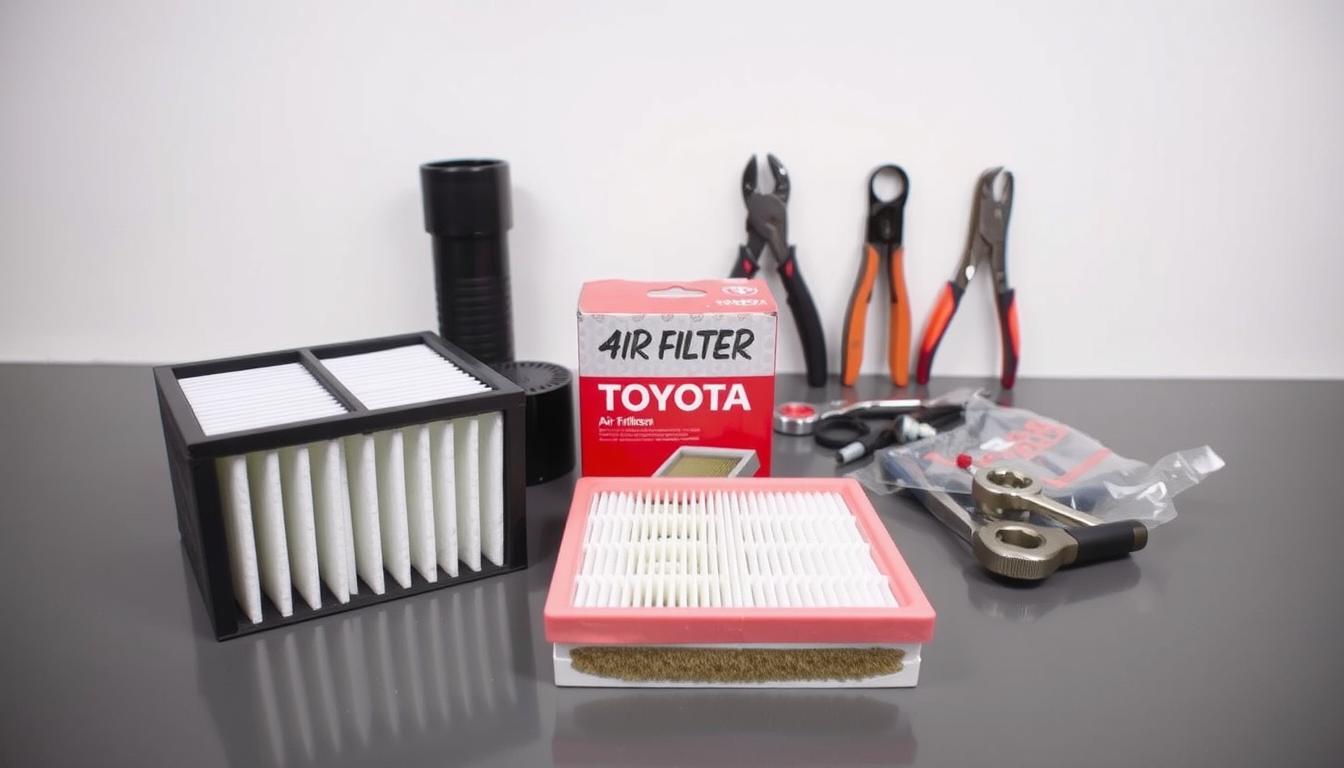Keeping your vehicle in top shape is all about the little things. Changing your Toyota air filter is one of the easiest and most important things you can do yourself.
Air filters protect your engine from dust and dirt. If they get too full, your engine works harder. This means it uses more fuel and loses power.
But here’s the bright side: swapping out these filters is a breeze. You can do it in under 15 minutes with a bit of practice. Changing them regularly can even boost your fuel efficiency by up to 34% on the highway. Plus, it’s way cheaper than taking it to a mechanic.
This guide is for all Toyota owners, no matter the model. You’ll find out when to change filters, what products to use, and how to do it quickly and easily.
Are you ready to make your Toyota run better? Let’s dive into this simple yet essential maintenance task.
Why Regular Air Filter Replacement Matters
Regularly changing your Toyota’s air filter is crucial for keeping your car running well. It acts as a shield for your engine, keeping out bad stuff and letting clean air in.
Many Toyota owners know the importance of oil changes. But, they often forget how vital a clean air filter is for their car’s health. A dirty filter makes your engine work harder, leading to many problems.
Impact on Engine Performance
A dirty air filter can really hurt your Toyota’s performance. It blocks airflow, making your engine struggle to get the right mix of air and fuel. This can make your car feel slow or weak when you try to speed up.
Modern Toyotas have special sensors to check airflow. If they find a blockage, they might turn on the check engine light or limit your car’s power to protect it.
Getting regular Toyota air filter service keeps your car running smoothly. It makes sure your Toyota stays responsive and efficient, even when you’re driving hard.
Fuel Efficiency Benefits
Your Toyota’s fuel efficiency depends on its air filter. A clean filter lets the right amount of air into the engine, making fuel burn efficiently.
A dirty air filter makes your Toyota use more fuel. This can cut your fuel economy by up to 10%, costing you a lot over time.
Let’s say you drive 15,000 miles a year in a Toyota that gets 30 MPG. A dirty air filter could cost you $150-200 extra in fuel each year. That’s a lot more than the cost of changing the air filter yourself.
| Air Filter Condition | Engine Performance | Fuel Economy | Long-term Effects |
|---|---|---|---|
| Clean | Optimal power and response | Maximum MPG | Extended engine life |
| Moderately Dirty | Slight power reduction | 3-5% MPG decrease | Increased engine wear |
| Severely Clogged | Significant power loss | 5-10% MPG decrease | Potential engine damage |
Understanding Toyota Air Filter Types
Knowing about the air filters in your Toyota is key for keeping your engine and cabin air clean. Your car has two filters that work together to keep you comfortable and safe. Each filter needs its own care and replacement schedule.
Toyota cars have engine and cabin air filters. They do different jobs but are both important. Let’s look at each to help you know when to replace them.
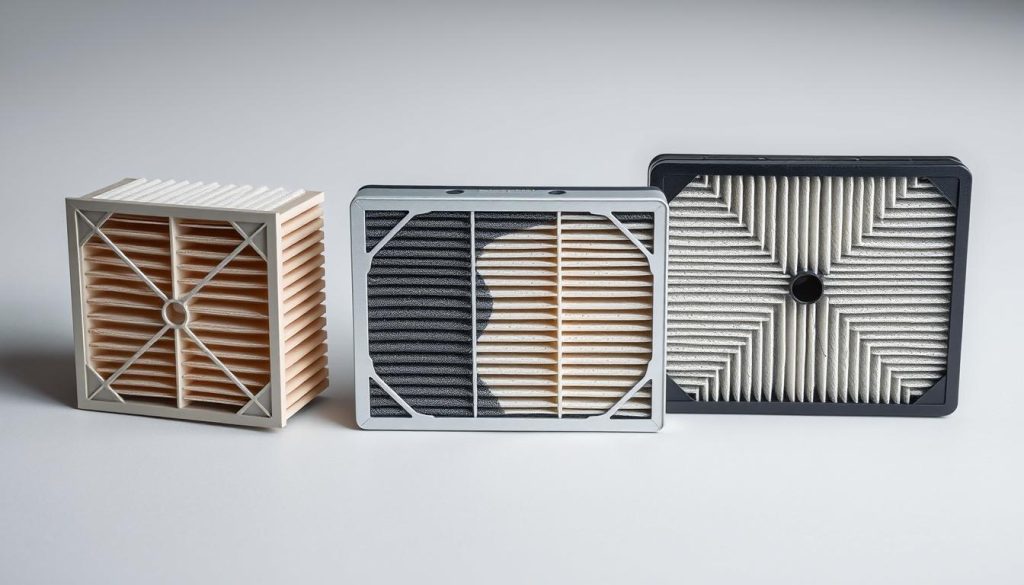
Engine Air Filters Explained
Engine air filters protect your car’s engine from harmful particles. They catch dirt and debris, keeping your engine running smoothly. Without them, your engine could get damaged.
Toyota makes engine air filters with specific airflow needs for each car. Most have a rectangular filter that fits into a special housing. This housing helps keep out road debris and water.
The filters have many pleats to catch more dirt. This means they can filter out particles as small as 5-10 microns. Knowing your car’s engine air filter type is crucial, as designs vary by model.
Cabin Air Filters Overview
Cabin air filters keep the air in your car clean. They don’t protect the engine like engine filters do. Instead, they make the air you breathe better.
Toyota cabin air filters trap dust, pollen, and mold. Some newer models have enhanced filters with activated carbon to get rid of bad smells. This makes your drive more enjoyable.
The cabin filter is usually behind the glove box or under the dashboard. It cleans the air for your car’s heating and cooling system. If you have allergies, changing this filter often is a must.
Change your cabin air filter every 12,000 to 15,000 miles or once a year. But, if you drive in polluted areas, you might need to change it more often. Toyota suggests more frequent changes for city drivers or those in dusty areas.
| Feature | Engine Air Filter | Cabin Air Filter |
|---|---|---|
| Primary Function | Protects engine components | Improves cabin air quality |
| Location | Engine compartment | Behind glove box or under dashboard |
| Replacement Interval | 15,000-30,000 miles | 12,000-15,000 miles |
| Signs of Failure | Reduced power, poor fuel economy | Poor HVAC performance, musty odors |
Tools and Materials Needed for Toyota Air Filter Replacement
Getting ready for your Toyota air filter DIY project is easy. You just need a few basic tools and a good replacement filter. Toyota made their cars easy to maintain, making air filter replacement simple. This way, you can save money and keep your engine running smoothly.
Most Toyotas have easy-to-reach air filters, needing little special gear. This shows Toyota’s effort to make maintenance simple for everyone. Let’s see what you’ll need to do the job right.
Essential Tools Checklist
Starting your Toyota air filter DIY replacement is all about having the right tools. For most Toyotas, you’ll need:
- Flathead screwdriver – for releasing clips on the air filter housing
- Phillips screwdriver (#2 size) – for removing screws securing the housing
- Flashlight or work light – to clearly see inside dark engine compartments
- Clean rags or microfiber cloths – for wiping down the filter housing
- Disposable gloves – to keep your hands clean during the process
Newer Toyotas might need extra tools like pliers or socket wrenches. A small vacuum with a brush can help clean the housing before putting in the new filter.
Before starting your Toyota air filter service, check your owner’s manual. It might tell you if you need any special tools for your model. This saves you from having to stop and look for something you forgot.
Recommended Air Filter Brands
Picking the right replacement filter is key for your Toyota’s performance. You have many good options:
Toyota Genuine Parts (OEM) filters fit perfectly and work best. They cost between $20-$35 for engine filters and $25-$45 for cabin filters, depending on your model. They also come with Toyota’s warranty and meet factory specs.
For other choices, trusted aftermarket brands include:
- Denso – A Toyota supplier with filters similar to OEM but a bit cheaper
- K&N – Offers reusable filters ($50-$70) that can be cleaned, saving money over time
- Fram – Provides affordable filters with good filtration
- Bosch – Known for high-quality filters with great dust-trapping
When looking at Toyota air filter price, remember that good aftermarket filters can be cheaper than OEM. They might cost up to 15% less but still work well. The best choice depends on your budget, driving, and how long you’ll keep your Toyota.
For the best engine protection, choose filters that meet or exceed Toyota’s standards. This is true for both OEM and aftermarket filters.
How to Locate Your Toyota’s Air Filters
Finding your Toyota’s air filters might seem hard at first. But, with the right help, it’s easy. Before you start any Toyota air filter replacement, you need to know where they are. Engine and cabin air filters are easy to get to for maintenance, but their spots change in different Toyotas.
Engine Air Filter Location by Model
Most Toyotas have their engine air filters in a black plastic box called the air filter housing. This box is in the engine area, but its exact spot changes with each model.
In sedans like the Camry and Corolla, the engine air filter is on the driver’s side. The housing has 2-3 clips that you can open by hand. Just open these clips, lift the air box top, and the filter is right there.
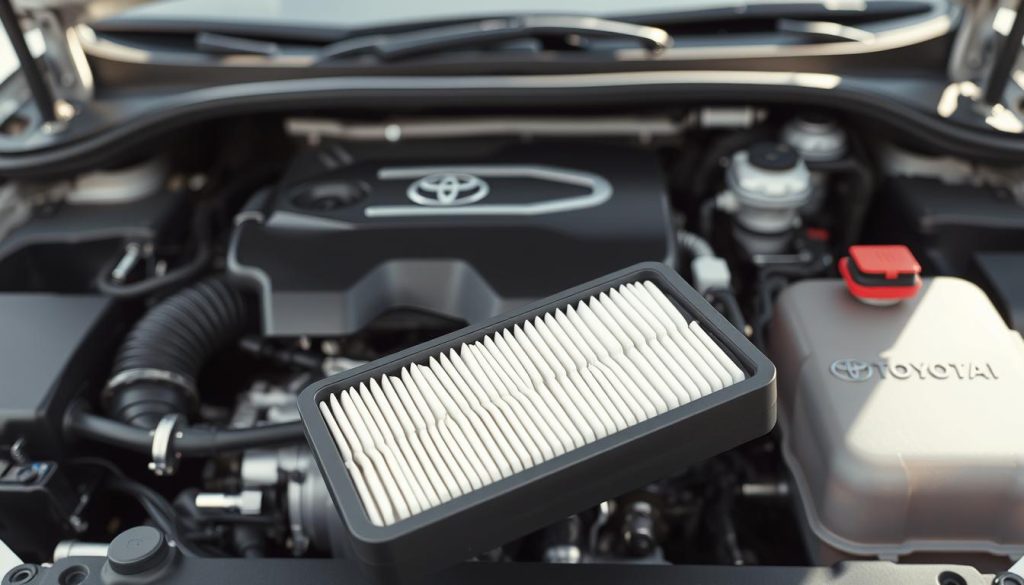
SUVs like the RAV4 and Highlander have a similar air filter housing but it’s often at the engine bay’s front. Trucks (Tacoma and Tundra) have a bigger air box near the fender well for better air intake.
Hybrid models, like the Prius, have a different engine area layout. Their air filter housing is usually on the passenger side. Newer Toyotas (2018 and later) might have the air box hidden under engine covers that you need to remove first.
Cabin Air Filter Location by Model
The cabin air filter in Toyotas is almost always behind or under the glove box. But, how you get to it changes with each model. This filter cleans the air that comes into your car through the heating and air conditioning.
For most sedans, like the Camry and Corolla, you need to empty the glove box first. Then, lower the glove box by pressing inward on both sides while pulling down. Some models need you to remove a stop pin or clip on the glove box’s side first.
In RAV4 and Highlander SUVs, the process is similar, but some years might need you to remove the glove box completely. Trucks like the Tacoma and Tundra often have the cabin filter under the dashboard on the passenger side, sometimes behind a panel rather than the glove box.
| Toyota Model | Engine Air Filter Location | Cabin Air Filter Location | Access Difficulty |
|---|---|---|---|
| Camry | Driver’s side engine bay | Behind glove box | Easy |
| Corolla | Driver’s side engine bay | Behind glove box | Easy |
| RAV4 | Front of engine bay | Behind glove box | Moderate |
| Tacoma | Near fender well | Under dashboard panel | Moderate |
| Prius | Passenger side | Behind glove box | Moderate |
Step-by-Step Toyota Engine Air Filter Replacement
Replacing your Toyota’s engine air filter is easy and doesn’t need special skills. You’ll need just a few tools and about 15-20 minutes. This Toyota air filter replacement will boost your engine’s performance. Here’s how to do it in simple steps.
Preparing Your Vehicle
Start by preparing your car for the Toyota air filter DIY job. Park on a flat surface and let the engine cool down if you’ve been driving. Hot parts can burn you if touched.
Turn off the engine and remove the key to avoid electrical problems. Open the hood and use the support rod to keep it up. Have all your tools and the new air filter ready to avoid delays.
Take a photo of the engine area before you start. This helps if you’re new to this. For newer Toyotas, like Camry or Highlander, find out which covers to remove to get to the air filter.
Accessing the Air Filter Housing
Finding and opening your Toyota’s air filter housing is easy once you know where it is. The air filter is in a black plastic box held by clips or clamps, usually on the engine’s side.
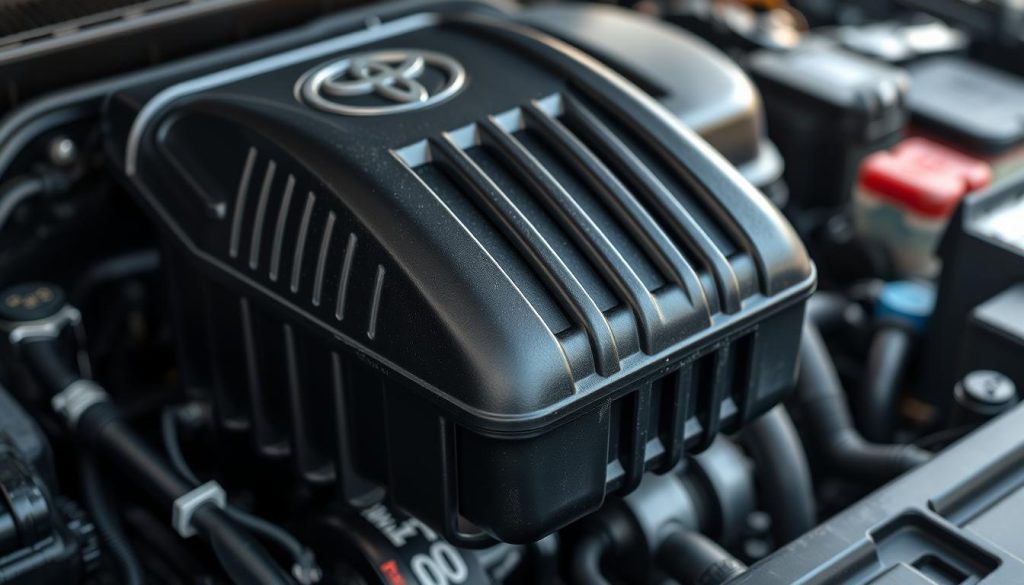
Look for the fasteners holding the air box shut. These are usually 2-4 clips around the housing. Pull them out or up, depending on your model. Some Toyotas, like the Tundra, use clips and screws.
For sedans like the Camry V6, you might need to disconnect the Mass Air Flow sensor or loosen a hose clamp. Be gentle with these parts to avoid damage. Once the fasteners are off, lift the housing top carefully. If it’s hard, check for any missed connections.
Removing and Installing the New Filter
Open the air filter housing to find the old filter. Lift it out, noting its airflow direction. A dirty filter means it’s time for a Toyota air filter change.
Clean the housing with a damp cloth before putting in the new filter. Don’t use compressed air, as it can push dirt further into the system.
Put the new filter in the housing, making sure it’s flat and properly seated. The airflow arrows should point toward the engine. This is important.
When putting the housing back together, align the tabs first. Then, secure the opposite side with the clips. For most Toyotas, start with the left side and then the right.
Check that everything is sealed and reconnect any hoses or electrical connections. This finishes your Toyota air filter service. It’s a simple task that keeps your engine running well.
Toyota Air Filter Replacement for Sedans and Compact Cars
Keeping your Toyota sedan or compact car’s air filters clean is key for its performance. The good news is that replacing them is easy. Most Toyota compact models have filter housings that are easy to get to. This makes Toyota air filter replacement a great DIY job. You can do it in a few minutes without any special tools, boosting your car’s efficiency and engine life.
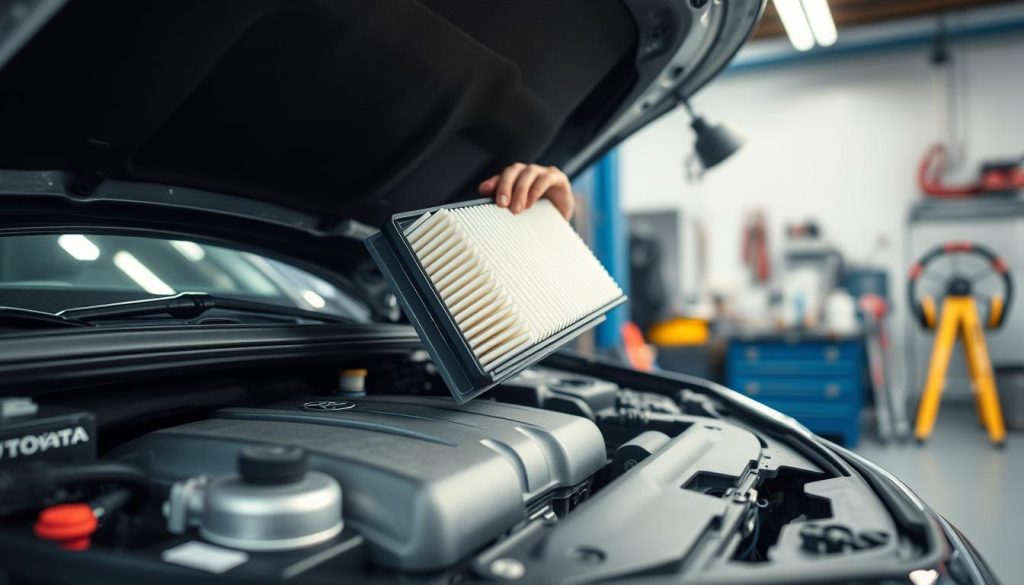
Camry Air Filter Replacement Guide
Replacing the air filter in a Toyota Camry is quick, taking less than 10 minutes. For models from 2012 to 2023, find the air filter housing on the driver’s side of the engine compartment.
Start by pulling the two metal spring-loaded clips outward to open the air box. V6 Camry owners might need to loosen a clamp with a screwdriver to disconnect the air intake tube. The filter then lifts straight out of its horizontal position.
When putting in a new Toyota air filter, make sure the rubber gasket seals well around the filter’s edges. Newer Camry models (2018+) have improved clips that are easier to use but need to be aligned correctly when closing the housing.
Corolla Air Filter Replacement Guide
The Toyota air filter change for Corolla models is simple and takes no special tools. It can be done in minutes. In most Corollas (2009-2023), the air filter housing is on the driver’s side of the engine bay, held by 2-3 clips.
After releasing these clips, the top of the housing opens up to show the filter. The Corolla’s small engine bay means you’ll need to be careful and methodical. When putting in the new filter, make sure it fits well in the housing grooves.
A typical Toyota air filter price for Corollas is between $15-$25. Cabin filters cost $20-$30. This makes it a cost-effective DIY job that improves your car’s performance and air quality.
Prius Air Filter Replacement Guide
The Toyota Prius has a special engine setup due to its hybrid powertrain. But Toyota air filter service is still easy to do. For most Prius models (2010-2023), the air filter housing is on the passenger side, hidden by hybrid system parts.
To get to the filter, release the 2-4 plastic clips holding the air box with gentle but firm pressure. The Prius’s filter is at an angle, so remember its position when removing. The airflow arrows should point down toward the engine.
To keep your Prius running efficiently, Toyota suggests Toyota air filter DIY replacement every 30,000 miles or sooner if it’s dusty. This is especially important for the hybrid’s fuel economy.
Yaris Air Filter Replacement Guide
The Toyota Yaris has one of the most accessible air filter designs. For all Yaris models (2007-2020), the air filter housing is right at the front of the engine compartment. It’s held by 2-3 metal clips that pull upward to release.
Once opened, the filter sits flat in the lower housing and lifts out easily. The design is simple, with no sensors or extra connections to deal with. The whole job takes about 3 minutes.
For the best results, use Toyota air filter OEM parts (part #17801-23030 for most Yaris models). They ensure a perfect fit and filtration. Keeping the air flowing well is key for the Yaris’s performance and efficiency.
Toyota Air Filter Replacement for SUVs and Trucks
Toyota SUVs and trucks have air filters that need special care. They face tough driving conditions, so keeping the air clean is key. We’ll look at how to replace air filters in Toyota’s popular SUVs and trucks.
RAV4 Air Filter Replacement Guide
The Toyota RAV4 makes replacing the air filter easy, with slight changes over the years. For models from 2013 to 2023, the air filter housing is on the driver’s side. It’s held by 2-4 plastic clips or clamps.
Newer RAV4s (2019 and up) have a special design. The air box connects directly to the intake manifold. You need to align the rubber seal carefully to avoid air leaks. The Hybrid version has the same steps.
When you take out the old filter, it might stick a bit. Lift it gently from all sides to avoid damage. Toyota suggests changing the filter every 30,000 miles. But, if you drive on rough roads often, do it every 15,000 to 20,000 miles.
Highlander Air Filter Replacement Guide
The Toyota Highlander has a big engine bay, making filter replacement easy. But, the steps vary for V6 and Hybrid models. For V6 Highlanders (2014-2023), the air filter housing is on the driver’s side, held by 3-4 clips or clamps.
Hybrid owners might find the housing hard to reach. The Highlander’s air box has a resonator chamber. Make sure all connections are sealed well to prevent leaks.
When putting in a new filter, align it well with the housing grooves. The Highlander’s filter is big, so it needs to fit right. New filters cost $20-$30 for aftermarket and $35-$45 for OEM. This is cheaper than what dealerships charge.
Tacoma Air Filter Replacement Guide
The Toyota Tacoma’s air filter system is tough for tough conditions. For models from 2005 to 2023, the housing is on the driver’s side. It’s held by 4-5 clips, which are stiffer than those in Toyota’s cars.
The Tacoma has a snorkel for cleaner air when off-roading. Always check this snorkel for debris when changing the filter. The Tacoma’s filter is bigger, needing more air.
V6 owners should make sure the Mass Air Flow sensor is connected well after replacing the filter. If you often go off-road, consider a high-performance filter. But, these need more frequent cleaning to keep air flowing well.
Tundra Air Filter Replacement Guide
The Toyota Tundra needs lots of airflow for its powerful engine. For models from 2007 to 2023, the air filter housing is at the front of the engine bay. It’s held by 4-6 clips or clamps, depending on the model and engine.
The Tundra’s air box has extra seals to keep air out of the engine. Make sure the new filter fits well in the housing channel. Toyota OEM filters (part #17801-0P010 for most 5.7L V8 models) are best for your Tundra’s engine.
OEM filters cost $35-$50, while quality aftermarket ones are $25-$40. This investment helps keep your Tundra’s towing capacity and engine strong. Given its work-oriented design, clean airflow is key for top performance.
| Toyota Model | Filter Location | Replacement Interval | OEM Filter Price | DIY Difficulty |
|---|---|---|---|---|
| RAV4 | Driver’s side engine bay | 30,000 miles (normal) 15,000 miles (dusty) |
$25-$35 | Easy |
| Highlander | Driver’s side engine bay | 30,000 miles | $35-$45 | Easy |
| Tacoma | Driver’s side with snorkel | 15,000-30,000 miles | $30-$40 | Moderate |
| Tundra | Front of engine compartment | 15,000-30,000 miles | $35-$50 | Moderate |
Step-by-Step Toyota Cabin Air Filter Replacement
Replacing your Toyota’s cabin air filter is easy and can make your car’s air much cleaner. This filter catches dust, pollen, and other particles before they get inside. With just a few tools and 15 minutes, you can do this Toyota air filter service yourself and save money.
Locating the Cabin Filter Housing
The first step is to find your cabin air filter. In most Toyotas, it’s behind the glove compartment. Start by emptying your glove box to avoid losing items.
Look for a stopper on the glove box’s right side. This needs to be removed to open the compartment. Press both sides of the glove box while pulling down to release it.
After lowering, you’ll see a plastic cover. This is the cabin filter housing. Some Toyota trucks have it under the dashboard on the passenger side. You might need to remove a panel to access it. Your owner’s manual has more information and diagrams for your model.
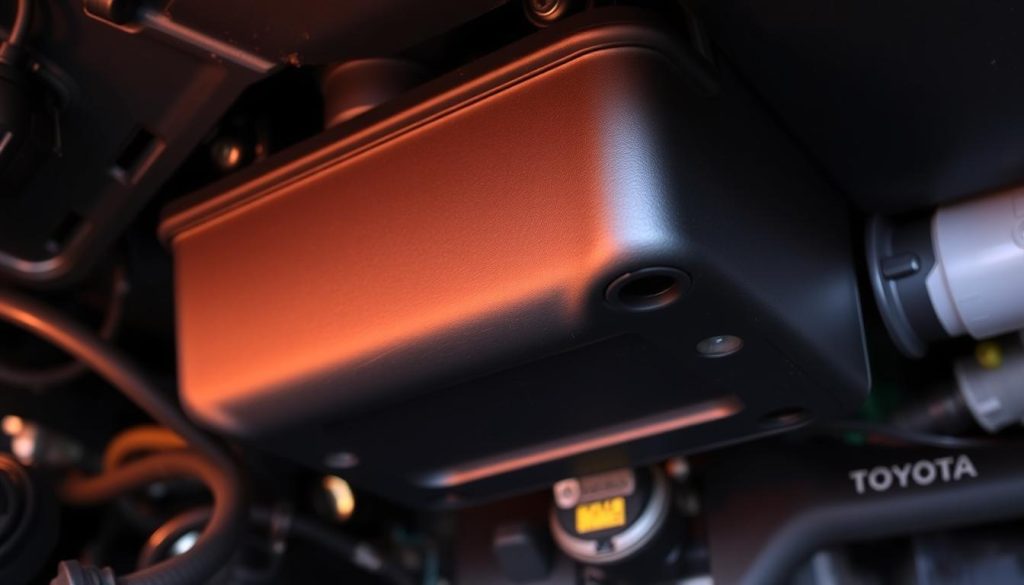
Removing the Old Cabin Filter
Now, you can change the Toyota air filter. Find out how the filter cover is held in place. Most Toyotas use plastic tabs or clips that you need to press or squeeze to open.
Apply gentle pressure to avoid breaking the tabs. If the tabs break, you might need to buy a new housing, which can be expensive.
Before taking out the old filter, note its airflow direction. This is important for installing the new one correctly. Slide the old filter out, pulling it straight toward you.
The old filter might be dirty and could have allergens. Avoid shaking it inside your car. If it’s very dirty or wet, you might need to replace it more often.
Also, check the housing for debris or leaves. Clean these out before putting in the new filter for better performance.
Installing the New Cabin Filter
Before you start, make sure the new filter matches the old one. The Toyota air filter price varies, from $15 to $40, depending on the type.
Check the new filter for the airflow direction arrow. It should point in the same direction as the old one. Slide the new filter into the housing, making sure it fits snugly against all edges.
The filter should fit well but shouldn’t be forced. For accordion-style filters, make sure the pleats are even and not damaged.
Once in place, put the housing cover back on. Align any tabs or guides first, then press firmly until all clips click into place.
Test your HVAC system by running the fan at different speeds. This ensures the air flows well. If airflow seems less than before, check that the filter is correctly installed.
| Cabin Filter Type | Price Range | Replacement Interval | Best For |
|---|---|---|---|
| Toyota OEM Standard | $20-30 | 15,000-30,000 miles | General use, factory specifications |
| Aftermarket Basic | $10-15 | 15,000 miles | Budget-conscious drivers |
| Premium with Activated Carbon | $25-40 | 15,000-30,000 miles | Odor control, allergen reduction |
| HEPA-Rated Filters | $30-45 | 15,000 miles | Allergy sufferers, urban environments |
Doing this Toyota air filter DIY project improves air quality and helps your HVAC system last longer. For the best results, replace the filter every 15,000-30,000 miles, as recommended in your owner’s manual.
Toyota Air Filter OEM vs. Aftermarket Options
Choosing the right air filter for your Toyota is important. It affects your car’s performance and your wallet. Let’s look at OEM and aftermarket filters to help you decide.
Benefits of Toyota OEM Air Filters
Toyota OEM air filters are made just for your car. They fit perfectly and seal well, keeping air clean.
These filters are tested to meet Toyota’s high standards. They ensure your engine gets the right air and catch harmful particles well.
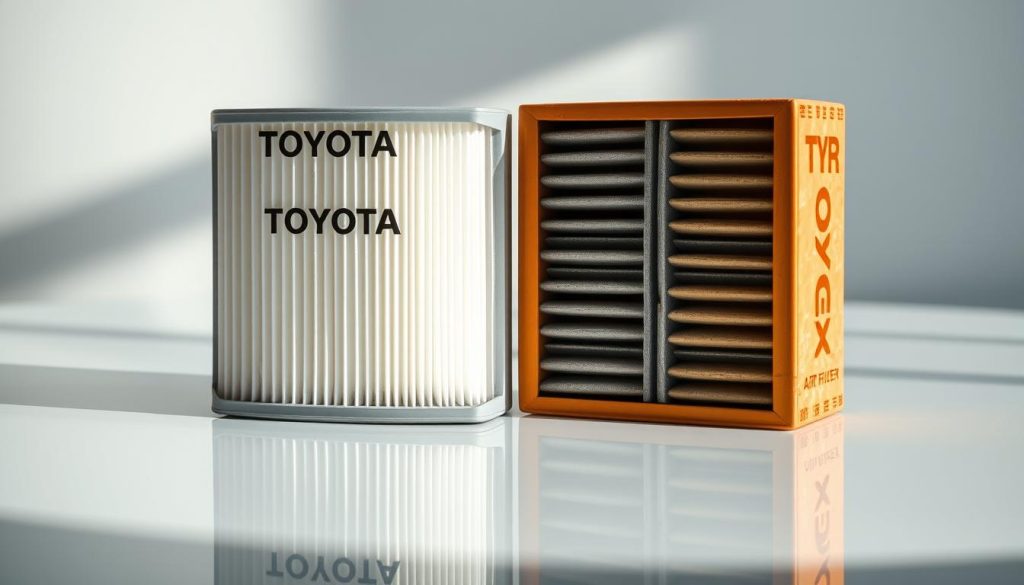
OEM filters have special media that catches tiny particles. They cost between $25-$45, depending on your car.
OEM filters are more expensive than some aftermarket ones. But they offer:
- 12-month or 12,000-mile warranty
- Perfect fitment
- Optimal airflow for your engine
- Consistent quality
For Toyota hybrids like the Prius, OEM filters are crucial. They match the engine’s airflow needs perfectly.
Quality Aftermarket Alternatives
The aftermarket has many air filter options for Toyotas. You can find affordable and high-performance filters. Brands like Denso and Bosch offer filters that are 15-30% cheaper than OEM ones but still filter well.
When choosing an aftermarket filter, make sure it meets Toyota’s standards. Look for filters with multi-layer media and a strong frame.
For those who want more power, consider filters from K&N and aFe. They can boost your car’s performance, especially in big engines like the Tundra.
- These filters use oiled cotton gauze
- Cost between $50-$80
- Can be cleaned and reused
- Need cleaning every 30,000-50,000 miles
For cabin air filters, aftermarket options include activated carbon or HEPA. They’re great for capturing allergens and odors, especially in polluted areas.
But, Toyota hybrid owners should be careful with aftermarket filters. They might trigger check engine lights due to the car’s sensitive sensors.
Toyota Air Filter Cost and Value Analysis
Understanding Toyota air filter costs is key to saving money. It’s important to compare prices and services to get the best value. This way, you can protect your engine and keep the air in your car clean without spending too much.
Price Comparison by Filter Type
Prices for Toyota air filters vary a lot. Engine air filters cost between $15-$45, depending on your car and the filter quality. Basic filters for cars like the Corolla and Camry start at $15-$20. But, genuine Toyota filters are $25-$35 for the same cars.
Bigger cars like the Highlander, 4Runner, and Tundra need bigger filters. These cost $5-$10 more than smaller car filters. This is because they need to filter more air for the bigger engines.

Cabin air filters are pricier than engine filters. Basic ones start at $10-$15, and Toyota’s own cost $25-$45. But, premium filters with extra features can cost $30-$60. They’re great for people with allergies.
For those who want the best, there are high-end filters. K&N’s reusable filters cost $50-$80 for engines and $40-$70 for cabins. They might cost more upfront but save money in the long run because you can clean them.
Shopping online can save you 10-30% compared to buying at a dealership. It’s especially good when you buy both engine and cabin filters together.
DIY vs. Professional Service Costs
Doing it yourself can save a lot of money on Toyota air filter replacements. It’s cheaper and lets you learn more about your car.
| Service Type | Average Cost (USD) | DIY Savings (%) | Time Required |
|---|---|---|---|
| Toyota Dealership | $85-120 | 0% | 1-2 hours (including wait) |
| Independent Garage | $55-75 | 40% | 30-60 minutes |
| Self Replacement | $15-45 (parts only) | 62-85% | 5-15 minutes |
Dealerships charge $50-$100 for engine filter changes and $50-$120 for cabin filters. The parts are only 30-40% of the cost, with the rest for labor. This job takes just 5-15 minutes.
Independent shops charge less, at $35-$75 for engine and $40-$90 for cabin filters. But, doing it yourself saves 60-80% of the cost of dealership service.
Replacing filters twice a year can save over $300 a year compared to dealership prices. Even if you follow Toyota’s recommended maintenance schedule, you can save over $500 in 10 years.
Doing it yourself also saves time. You won’t have to wait at a service center. Replacing air filters is a great way for Toyota owners to start with DIY car maintenance.
Recommended Toyota Air Filter Replacement Schedule
Knowing when to replace your Toyota’s air filter is key to keeping your car running well. Regular Toyota air filter replacement helps protect your engine and keeps your car running smoothly. Let’s look at the recommended schedule and how to adjust it for your driving habits.
Manufacturer Guidelines
Toyota has set up specific maintenance schedules based on lots of testing and real-world data. For most models, they say to change the engine air filter every 30,000 miles. This helps keep your engine clean without costing too much.
Cabin air filters need to be changed more often. Toyota recommends doing this every 15,000-20,000 miles or every 12-18 months, whichever comes first. You can find these guidelines in your car’s Warranty and Maintenance Guide.
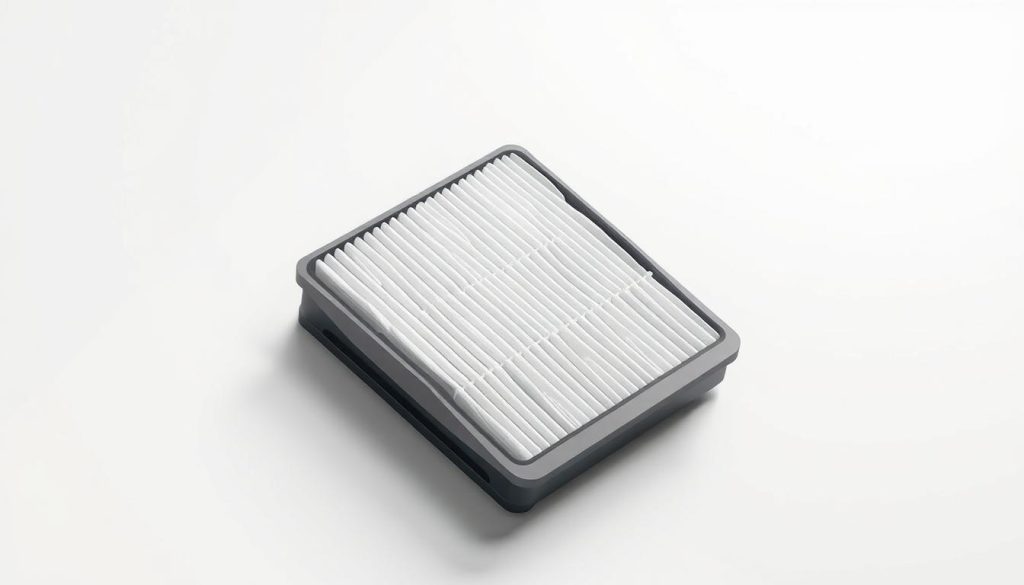
Newer Toyotas (2017 and later) have a system that reminds you when it’s time for service. This system takes into account both how far you’ve driven and how long it’s been. If you bought a new Toyota, the ToyotaCare program might cover your first air filter service if it fits within the program’s time and mileage limits (usually 2 years/25,000 miles).
Hybrid cars like the Prius and RAV4 Hybrid have the same maintenance schedule as non-hybrid models. This is true even though they have different engines.
Adjusting for Driving Conditions
While Toyota’s standard schedule is for “normal” driving, many drivers need to change their air filters more often. Here are some tips based on where and how you drive:
- Dusty areas (unpaved roads, construction): Change engine air filters every 15,000-20,000 miles
- Busy cities with lots of pollution: Replace cabin filters every 10,000 miles or 6-9 months
- Off-roading: Check engine air filters after using trails a lot
- Coastal areas: Change cabin filters every 10,000 miles because of salt in the air
Seasons also play a role in when you should replace your air filters. For people with allergies, getting a new cabin filter before pollen season starts can make a big difference. In areas with lots of farming, you might need to change your filters more often during planting and harvesting.
The best Toyota air filter advice is to check them regularly. If your filter looks dirty or you can’t see through it, it’s time for a new one. This simple check can help you keep your car in top shape, no matter where you drive.
Signs Your Toyota Needs a New Air Filter
Knowing when your Toyota needs a new air filter is key to keeping it running well. Your car will send you signals that you shouldn’t ignore. Catching these signs early can stop bigger problems and keep your Toyota running smoothly for years.
Engine and cabin air filters are vital for your Toyota’s health. When they get clogged, your car’s performance drops. Here are the main signs it’s time for a Toyota air filter change.
Engine Performance Indicators
Your Toyota will show signs of air filter trouble in how it drives. A slow start when you press the gas pedal is common. This is because a clogged air filter makes it hard for your engine to breathe.
Other signs include hesitation when merging onto highways or needing more gas than usual. Modern Toyotas might show small signs like an irregular idle or slight hesitation when accelerating.
A drop in fuel efficiency by 5-10% means your engine is working harder. This is because it’s not getting enough air. In newer Toyotas (2017+), a bad air filter might even turn on the check engine light.
Hybrid Toyotas like the Prius and RAV4 Hybrid might use more gas when the engine works harder. Listen for a strained sound when accelerating. This usually means your engine is not getting enough air.
Visual Inspection Tips
The best way to know if your Toyota needs a new air filter is to look at it. For engine air filters, take it out and hold it up to light. If you can’t see light through it, it’s time for a Toyota air filter replacement.
Look for dirt on the pleats. A little dirt is okay, but a lot means it’s full. A new filter is usually white or off-white. A dirty one will be gray, brown, or black.
For cabin air filters, look for grayish-black color. This means it’s full of pollution. Also, watch for mold or mildew, which looks like green or black spots. It can make bad smells and harm your health.
| Inspection Method | Engine Air Filter | Cabin Air Filter | Action Needed |
|---|---|---|---|
| Light Test | Cannot see light through filter | Significantly blocked light | Replace immediately |
| Color Check | Dark gray/black appearance | Grayish-black discoloration | Replace filter |
| Physical Condition | Torn/damaged pleats | Warped frame or mold present | Replace and inspect housing |
| Dirt Accumulation | Heavy buildup on pleats | Visible debris/particles | Replace during Toyota air filter service |
Reduced airflow, more allergies, or bad smells mean your cabin air filter needs help. The simplest Toyota air filter DIY check is to hold it up to light. If you can’t see through it, it’s time to replace it.
Checking both types of filters regularly is important. Catching these signs early keeps your Toyota running well and keeps the air clean for you and your passengers.
Common Mistakes to Avoid During Toyota Air Filter Replacement
Replacing your Toyota’s air filter might seem easy, but mistakes can happen. Knowing these common errors can save you time, money, and stress. Let’s look at the most common mistakes and how to avoid them.
Installation Errors
One big mistake is putting the filter in the wrong way. Toyota air filters have arrows showing the airflow direction. Putting it in the wrong way can make it less effective and damage the filter.
Another mistake is not seating the filter right. If it’s not in its housing channel correctly, air can go around it. This often happens when you’re in a hurry or it’s dark.
Securing the air box after replacing the filter can be tricky. A ’07 Toyota sedan owner said: “I spent 30 minutes trying to align the cover and filter so the clips would align enough to snap!” To fix this, align one side’s tabs or hinges before closing the other.
Not marking where sensors or electrical connections are can cause problems. Also, not cleaning the filter housing before putting in the new filter can make it less effective.
Filter Selection Mistakes
Choosing a filter just by price without checking if it fits your Toyota is a bad idea. Different engines in the same model might need different filters.
Some people pick universal filters that don’t fit well. This lets unfiltered air get through, which can harm your engine over time.
For everyday driving, picking a filter that lets too much air through can let more dirt in. This is especially bad for Toyota hybrid models, as it can mess with sensor readings and cause check engine lights.
Going for the cheapest filter without thinking about quality can save a little money but cost more in the long run. It can lead to engine damage and expensive repairs.
When deciding between Toyota air filter OEM and aftermarket, be careful of aftermarket filters that promise longer service life. These can be a problem in dusty or polluted areas where filters need to be changed more often.
Conclusion
Keeping your Toyota’s air filters clean is a simple yet powerful maintenance step. This guide showed that replacing Toyota air filters is easy, needing just basic tools and skills. It’s great for those who like to do car work themselves.
Regularly changing your engine air filter protects your engine and saves fuel. A clean cabin air filter means you breathe better air and your climate control works better.
Doing it yourself can save you 60-80% compared to dealership prices. This makes it a very cost-effective car care task to learn.
If you drive in dusty places, during pollen season, or in busy traffic, check your filters more often. These conditions can make filters dirty faster than Toyota’s usual change times.
Whether you own a Camry, Corolla, RAV4, or Tundra, the care for air filters is the same. With the tips from this article, you can keep your Toyota’s air system in great condition.
Adding air filter replacement to your regular car care routine is a smart move. It improves your car’s performance, efficiency, and air quality for many years.
FAQ
How often should I replace my Toyota’s engine air filter?
Toyota suggests changing your engine air filter every 30,000 miles if you drive normally. But, if you often drive in dusty places or areas with lots of pollution, change it every 15,000-20,000 miles. Checking the filter regularly can also tell you when it needs to be replaced sooner.
How much does a Toyota air filter replacement cost?
Engine air filters for Toyotas cost between -, depending on the quality and where you buy it. OEM filters from Toyota dealerships are -. Aftermarket filters start at -. Cabin air filters cost a bit more, with OEM versions from – and aftermarket ones starting at -. Replacing them yourself can save you -0 compared to going to a dealership.
Can I replace my Toyota’s air filters myself?
Yes! Replacing Toyota air filters is easy and doesn’t need much skill or tools. Most Toyotas make it simple to get to both engine and cabin air filters. You’ll need a screwdriver and about 10-15 minutes per filter. The steps are clear in your owner’s manual.
Where is the engine air filter located in my Toyota?
In most Toyota sedans like the Camry and Corolla, the engine air filter is in a black plastic box on the driver’s side of the engine. SUVs like the RAV4 have it towards the front of the engine bay. Toyota trucks have a larger air box near the fender well. Your owner’s manual has diagrams for your specific model.
How do I know if my Toyota needs a new air filter?
Look for signs like slower acceleration, worse fuel economy, or rough idling. Check the filter by removing it and shining a light through it—if you can’t see light or it’s dark, it’s time for a new one. Also, look for any damage like tears or collapsed pleats.
Are OEM Toyota air filters worth the extra cost?
Toyota OEM air filters fit perfectly, seal well, and filter efficiently for your vehicle. They cost 30-40% more than basic aftermarket filters but come with warranty protection. For hybrid models, OEM filters are especially good. But, quality aftermarket filters from brands like Denso or Bosch can offer similar performance at a lower price.
Where is the cabin air filter located in Toyota vehicles?
In most Toyotas, the cabin air filter is behind the glove compartment. You’ll need to empty and lower the glove box to get to it. Some trucks like the Tacoma have it under the dashboard on the passenger side, sometimes behind a panel. Your owner’s manual will tell you where it is for your model.
How often should I replace my Toyota’s cabin air filter?
Toyota says to replace cabin air filters every 15,000-20,000 miles or 12-18 months, whichever comes first. If you drive in polluted areas or have allergies, change it more often—every 10,000 miles or 6-9 months. Spring pollen can also make it clog faster.
What tools do I need to replace my Toyota’s air filters?
For most Toyotas, you’ll need a flathead screwdriver for clips, a Phillips screwdriver for screws, and pliers for hose clamps. A flashlight helps with visibility, and clean rags are good for wiping down the housing. Disposable gloves keep your hands clean. You won’t need any special tools.
Can a dirty air filter damage my Toyota’s engine?
Yes, a dirty air filter can harm your engine over time. It can cause your engine to use more fuel and lead to carbon buildup. This can stress your engine. Modern Toyotas with direct injection need clean air to run well.
What’s the difference between engine and cabin air filters in my Toyota?
Engine air filters keep your engine safe by filtering the air for combustion. They stop dust and debris from getting in and damaging your engine. Cabin air filters, on the other hand, improve air quality for you and your passengers by filtering the air from your HVAC system.
Are reusable air filters like K&N worth it for my Toyota?
Reusable filters from brands like K&N cost – initially but can be cleaned instead of replaced. They can be a good deal for long-term ownership. They might offer a slight performance boost, especially in bigger engines. But, they need maintenance every 30,000-50,000 miles and might not be best for hybrid models.
